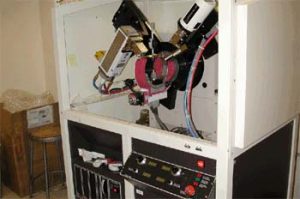X-Ray Diffraction Laboratory
 Powder x-ray diffraction analysis for mineral identification and crystallographic characterization of earth and man-made materials
Powder x-ray diffraction analysis for mineral identification and crystallographic characterization of earth and man-made materials
Contact: Dr. Marty Yates
The Department of Geological Sciences at the University of Maine acquired a fully automated Scintag, Inc. x-ray diffraction laboratory purchased through an NSF Equipment and Facilities grant and matching money from the University of Maine and UM’s Laboratory for Surface Science and Technology in 1998.
This Scintag XRD system includes the following components:
- 4.0 kW High Voltage Generator
- Theta/Theta Goniometer
- Continuously Adjustable Slits
- Computer controlled incident beam slits
- X2 Diffraction Microprocessor Assembly
- Fine Focus, Copper Target X-Ray Tube
- DMS/NT Data Acquisition And Analysis Software
- Crystallographic Analysis Software
- Quantitative Analysis Software
- Thermoelectically-Cooled, Solid-State Peltier X-Ray Detector.
- Half circle pole figure and stress attachment
- DMS/NT Stress Analysis Software
- DMS/NT Reflectometry Software
- DMS/NT Polar 3-D, Texture Analysis Software
- Parabolic Incident Beam X-Ray Mirror
- Thin Film Grazing Angle Collimation Attachment.
- ICDD Powder Diffraction Database
- Windows 8 Control and Data Processing Computer
- Haskris, Inc. Water-to-Water Chiller.
With this instrumentation, we have the ability to:
- Identify Mineral Unknowns using the ICDD Powder Diffraction Database
- Determine Quantitatively the Quantity of Qrystalline Phases in a Mixture
- Determine Quantitatively the Lattice Parameters of Crystalline Phases
- Determine Quantitatively the Degree of Crystallinity of Crystalline Phases
- Determine the Structure of Thin-Films at Grazing Incidence Angles
- Determine Quatitatively the Degree and Orientation of Prefered Orientation in Polycrystalline Materials

